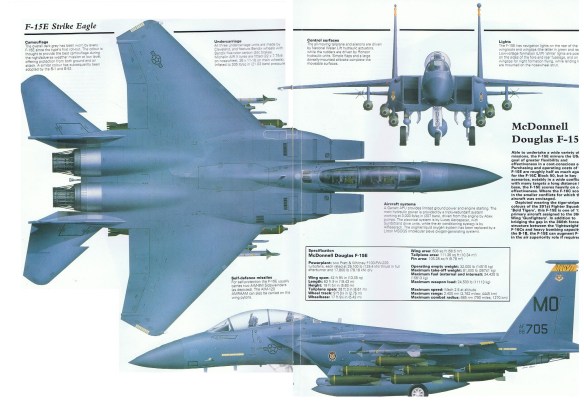
The Eagle was the first American air-superiority fighter since the F86 Sabre and has already served for a quarter-century. It combines high performance, gut-wrenching agility, and state-of-the-art electronics into a single deadly package.
During the late 1960s the Air Force began contemplating a replacement for its superb but aging F4 Phantom II. Whereas most warplanes of the 1960s were actually multirole fighter-bombers, the new aircraft was intended specifically as an air-superiority fighter. McDonnell-Douglas won the design competition, and in July 1972 it rolled out the prototype XF15. Unlike the F4, this was a single-seat fighter with twin engines and tails and all-moving horizontal tail surfaces. Moreover, because the craft possessed more engine thrust than weight, it was the first American fighter able to accelerate during vertical climb. Its broad, sharp, swept wing ensured low wing loading (the ratio of weight to wing area), so that it enjoyed high maneuverability. In 1974 the F15A entered into service as the Eagle; since then nearly 1,000 have been deployed.
The F15 enjoys heads-up displays, which are state-of-the-art instruments viewed through the canopy so a pilot can monitor the craft and never take an eye off the target. Furthermore, advanced electronics and radar enable the Eagle to detect enemy aircraft at great distances and engage them before visual contact is established. During the 1980s a two-seat ground-attack version, the F15E Strike Eagle, was developed; it remains a highly effective bomber. The F15 enjoyed a brilliant career in Israeli hands and in one skirmish claimed 60 Syrian MiGs without loss. During the 1991 Gulf War, Eagles shot down 35 Iraqi jets in exchange for two F15Es lost to ground fire. This superb fighter, one of the best ever built, will be flying well into the next century.
Strike Eagle
Perhaps the ultimate development of the F-15 to date has been the F-15E Strike Eagle. McDonnell Douglas and radar manufacturer Hughes teamed up in 1979 to privately develop a ground attack/strike version of the Eagle and the aircraft would go on to be successful in the 1981 Enhanced Tactical Fighter (ETF) competition to provide a replacement for the F-111 Aardvark.
An order was placed in February 1984 and the first F-15E Strike Eagle took to the sky on December 11, 1986 and 236 were built for the USAF.
The F-15E differs from earlier Eagles by virtue of significant structural changes, more powerful engines and large conformal fuel tanks. The rear seat is equipped for a Weapon Systems Officer who operates screens to display information from the radar and sensors. The rear seat also boasts a full set of flying controls.
The first production model of the F-15E was delivered to the USAF in April 1988 and production continued until 2001 with 236 produced for the Air Force.
There was an attempt to develop the type further into the F-15G Wild Weasel to replace the F-4G Wild Weasel in the Suppression of Enemy Air Defences (SEAD) role, but F-16Cs were eventually modified to perform this role. Boeing, which now owns McDonnell Douglas, is currently developing the F-15SE Silent Eagle using `fifth generation’ fighter features including internal weapons carriage and radar-absorbent materials.
Of course the USAF also deployed the Eagle to the Gulf and the type accounted for 36 of the 39 air-to-air victories claimed by the Air Force. The F-15C fleet claimed 34 of those victories including eight MiG-23s, five MiG- 29 Fulcrums, four Su-22 Fitters as well as pairs of MiG-25s, MiG-21s, Su-25 Frogfoots. Other victories included a Su-7, six Mirage F-1s, an Il-76 Candid, a PC-9 trainer and a pair of Mil Mi-8 helicopters, showing just how versatile the Eagle is in the air-to-air role. Although mostly used in the ground attack role the F-15E Strike Eagles also claimed an air-to-air kill in Desert Storm when one `shot down’ a Mi-8 helicopter with a laser guided bomb. Air superiority was achieved in the first three days of the conflict; thanks mainly to the Eagle fleet.
USAF Eagles have also seen operational ser vice during Operation Southern Watch (the patrolling of the No-Fly Zone in Southern Iraq), Operation Provide Comfort in Turkey (in support of NATO operations in Bosnia) and in 1999 four Yugoslavian MiG-29s were shot down by F-15Cs during Operation Allied Force in Kosovo.
Following the adoption of United Nations Security Council Resolution 1973 in March 2011, ten F-15E Strike Eagles were deployed to enforce the Libyan no-fly zone as part of Operation Odyssey Dawn. On March 21, 2011, F-15E 91-304 crashed near Bengazi and both crew members parachuted into territory held by the Libyan resistance movement before being rescued by US Marines. Equipment problems are believed to have caused a weight imbalance and contributed to the crash.
To date the Eagle fleet has a combined record of 104 kills for no air-to-air combat losses, with more than half of those victories achieved by Israeli Air Force pilots.
The final F-15A retired (from the Oregon Air National Guard) on September 16, 2009, bringing to an end the early Eagles’ service in the USA. Within the USAF fleet the F-15C and D is now operating alongside the F-22 Raptor but there’s no sign of the type retiring any time soon. In fact, 178 F-15Cs and 224 F-15Es are being upgraded with a view to them remaining in service beyond 2025. You’ve not seen the last of this impressive aircraft just yet.